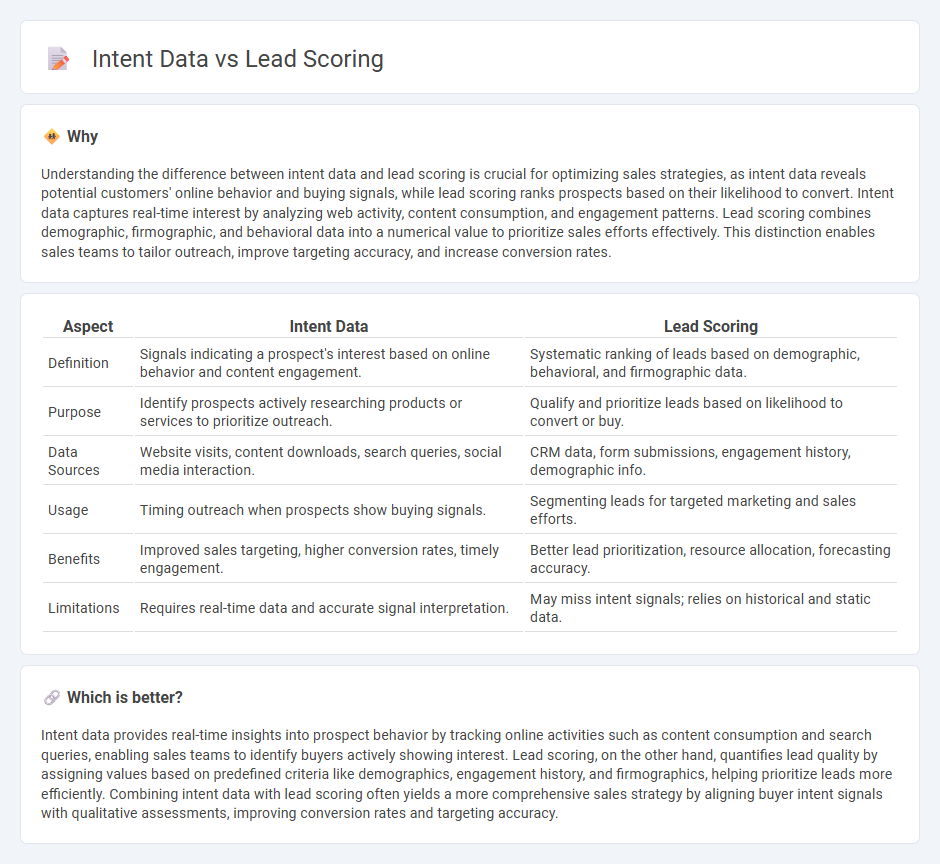
Intent data captures real-time online behavior signals indicating a potential buyer's interest, while lead scoring ranks prospects based on demographic and engagement attributes to prioritize sales efforts. Combining intent data with lead scoring enhances targeting accuracy by identifying not only who to approach but also when they are most ready to buy. Discover how integrating these strategies can boost your sales pipeline effectiveness.
Why it is important
Understanding the difference between intent data and lead scoring is crucial for optimizing sales strategies, as intent data reveals potential customers' online behavior and buying signals, while lead scoring ranks prospects based on their likelihood to convert. Intent data captures real-time interest by analyzing web activity, content consumption, and engagement patterns. Lead scoring combines demographic, firmographic, and behavioral data into a numerical value to prioritize sales efforts effectively. This distinction enables sales teams to tailor outreach, improve targeting accuracy, and increase conversion rates.
Comparison Table
| Aspect | Intent Data | Lead Scoring |
|---|---|---|
| Definition | Signals indicating a prospect's interest based on online behavior and content engagement. | Systematic ranking of leads based on demographic, behavioral, and firmographic data. |
| Purpose | Identify prospects actively researching products or services to prioritize outreach. | Qualify and prioritize leads based on likelihood to convert or buy. |
| Data Sources | Website visits, content downloads, search queries, social media interaction. | CRM data, form submissions, engagement history, demographic info. |
| Usage | Timing outreach when prospects show buying signals. | Segmenting leads for targeted marketing and sales efforts. |
| Benefits | Improved sales targeting, higher conversion rates, timely engagement. | Better lead prioritization, resource allocation, forecasting accuracy. |
| Limitations | Requires real-time data and accurate signal interpretation. | May miss intent signals; relies on historical and static data. |
Which is better?
Intent data provides real-time insights into prospect behavior by tracking online activities such as content consumption and search queries, enabling sales teams to identify buyers actively showing interest. Lead scoring, on the other hand, quantifies lead quality by assigning values based on predefined criteria like demographics, engagement history, and firmographics, helping prioritize leads more efficiently. Combining intent data with lead scoring often yields a more comprehensive sales strategy by aligning buyer intent signals with qualitative assessments, improving conversion rates and targeting accuracy.
Connection
Intent data captures potential buyers' online behaviors and signals indicating their readiness to make a purchase, which enhances the accuracy of lead scoring models. By integrating intent data into lead scoring, sales teams can prioritize prospects demonstrating high purchase intent, increasing the efficiency of sales outreach. This data-driven approach boosts conversion rates by focusing resources on leads with the strongest likelihood to convert.
Key Terms
Lead Scoring:
Lead scoring assigns values to prospects based on demographics, behaviors, and engagement levels to prioritize sales efforts effectively. It leverages historical customer data, such as website visits, email opens, and content downloads, to predict conversion likelihood. Explore how lead scoring can enhance your sales strategy and increase conversion rates.
Qualification Criteria
Lead scoring evaluates prospects based on demographic, behavioral, and firmographic data to prioritize sales efforts, while intent data captures real-time signals indicating a potential buyer's active interest or intent to purchase. Qualification criteria in lead scoring often include job title, company size, and engagement history, whereas intent data focuses on content consumption patterns and keyword searches relevant to buying stages. Explore deeper insights into how combining lead scoring and intent data enhances precision in lead qualification and sales targeting.
Score Threshold
Lead scoring quantifies potential customer quality by assigning numerical values based on demographics, behaviors, and engagement, while intent data captures real-time signals reflecting a prospect's interest or buying intent. The score threshold in lead scoring establishes the minimum point at which a lead is considered qualified for sales outreach, ensuring efficient prioritization of high-probability prospects. Explore how adjusting score thresholds and integrating intent data can enhance your lead qualification process.
Source and External Links
Lead scoring - Wikipedia - Lead scoring is a methodology used to rank prospects based on their perceived value to the organization, using explicit data like company size and implicit data from prospect behavior to prioritize sales engagement and improve marketing-sales alignment and revenue growth.
The Ultimate Guide to Lead Scoring - ActiveCampaign - Lead scoring is a systematic way to rank potential customers by likelihood to purchase using a step-by-step process that starts with defining minimum customer criteria and identifying key target market characteristics to optimize sales focus.
Lead Scoring Explained: How to Identify and Prioritize High-Quality Leads - HubSpot - Lead scoring assigns values to leads to quantify how likely they are to become customers, with predictive lead scoring using machine learning to continually improve the lead prioritization process for sales efficiency.
 dowidth.com
dowidth.com